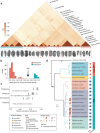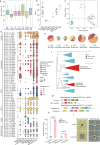Genomic insights into the phylogeny and biomass-degrading enzymes of rumen ciliates
- PMID: 35986094
- PMCID: PMC9666518
- DOI: 10.1038/s41396-022-01306-8
Genomic insights into the phylogeny and biomass-degrading enzymes of rumen ciliates
Abstract
Understanding the biodiversity and genetics of gut microbiomes has important implications for host physiology and industrial enzymes, whereas most studies have been focused on bacteria and archaea, and to a lesser extent on fungi and viruses. One group, still underexplored and elusive, is ciliated protozoa, despite its importance in shaping microbiota populations. Integrating single-cell sequencing and an assembly-and-identification pipeline, we acquired 52 high-quality ciliate genomes of 22 rumen morphospecies from 11 abundant morphogenera. With these genomes, we resolved the taxonomic and phylogenetic framework that revised the 22 morphospecies into 19 species spanning 13 genera and reassigned the genus Dasytricha from Isotrichidae to a new family Dasytrichidae. Comparative genomic analyses revealed that extensive horizontal gene transfers and gene family expansion provided rumen ciliate species with a broad array of carbohydrate-active enzymes (CAZymes) to degrade all major kinds of plant and microbial carbohydrates. In particular, the genomes of Diplodiniinae and Ophryoscolecinae species encode as many CAZymes as gut fungi, and ~80% of their degradative CAZymes act on plant cell-wall. The activities of horizontally transferred cellulase and xylanase of ciliates were experimentally verified and were 2-9 folds higher than those of the inferred corresponding bacterial donors. Additionally, the new ciliate dataset greatly facilitated rumen metagenomic analyses by allowing ~12% of the metagenomic sequencing reads to be classified as ciliate sequences.
© 2022. The Author(s), under exclusive licence to International Society for Microbial Ecology.
Conflict of interest statement
The authors declare no competing interests.
Figures





References
-
- Lynn DH. The Ciliated Protozoa: Characterization, Classification, and Guide to the Literature. 3rd ed. Heidelberg: Springer; 2008.
Publication types
MeSH terms
LinkOut - more resources
Full Text Sources
Molecular Biology Databases

